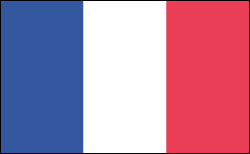France

Geography
France is about 80% the size of Texas. In the Alps near the Italian and Swiss borders is western Europe's highest point—Mont Blanc (15,781 ft; 4,810 m). The forest-covered Vosges Mountains are in the northeast, and the Pyrénées are along the Spanish border. Except for extreme northern France, the country may be described as four river basins and a plateau. Three of the streams flow west—the Seine into the English Channel, the Loire into the Atlantic, and the Garonne into the Bay of Biscay. The Rhône flows south into the Mediterranean. For about 100 mi (161 km), the Rhine is France's eastern border. In the Mediterranean, about 115 mi (185 km) east-southeast of Nice, is the island of Corsica (3,367 sq mi; 8,721 sq km).
Government
Fifth republic.
History
Archeological excavations indicate that France has been continuously settled since Paleolithic times. The Celts, who were later called Gauls by the Romans, migrated from the Rhine valley into what is now France. In about 600 B.C. , Greeks and Phoenicians established settlements along the Mediterranean, most notably at Marseille. Julius Caesar conquered part of Gaul in 57–52 B.C. , and it remained Roman until Franks invaded in the 5th century A.D.
The Treaty of Verdun (843) divided the territories corresponding roughly to France, Germany, and Italy among the three grandsons of Charlemagne. Charles the Bald inherited Francia Occidentalis, which became an increasingly feudalized kingdom. By 987, the crown passed to Hugh Capet, a princeling who controlled only the Ile-de-France, the region surrounding Paris. For 350 years, an unbroken Capetian line added to its domain and consolidated royal authority until the accession in 1328 of Philip VI, first of the Valois line. France was then the most powerful nation in Europe, with a population of 15 million.

